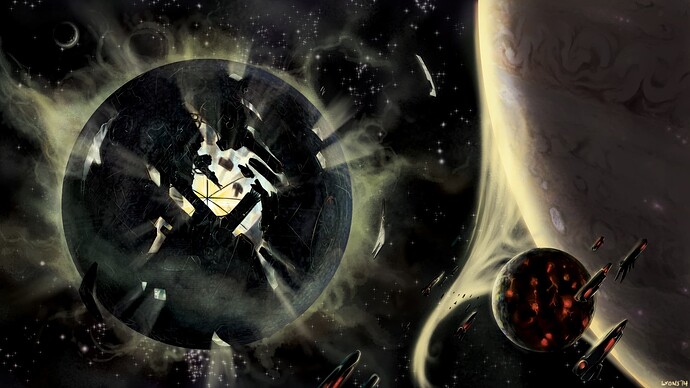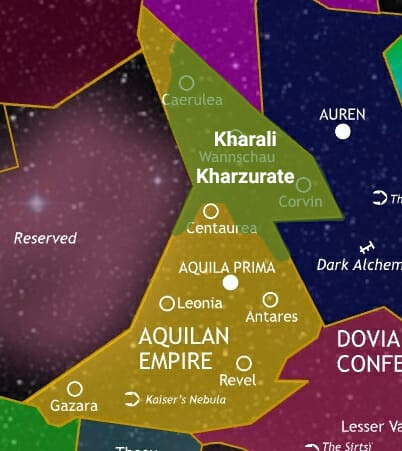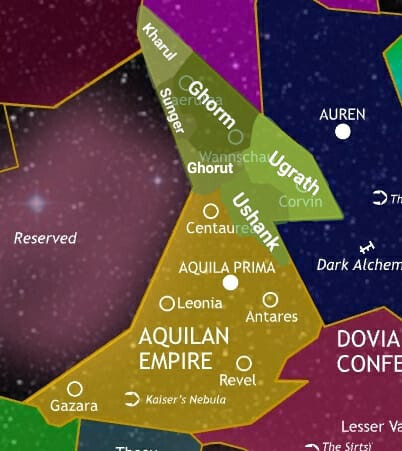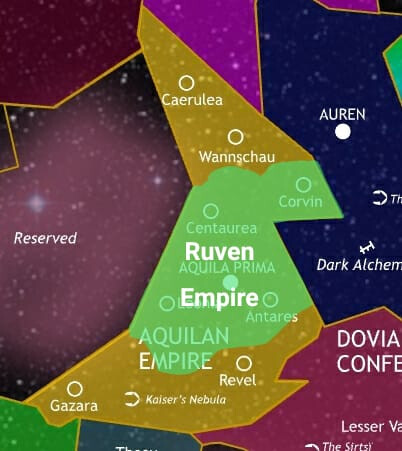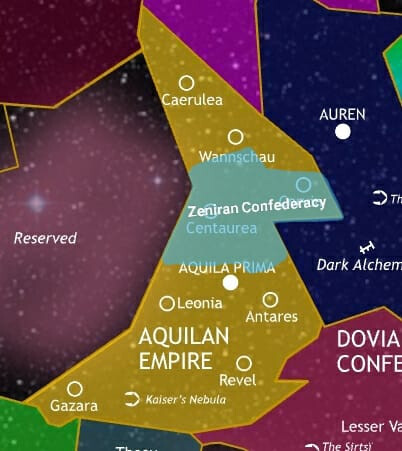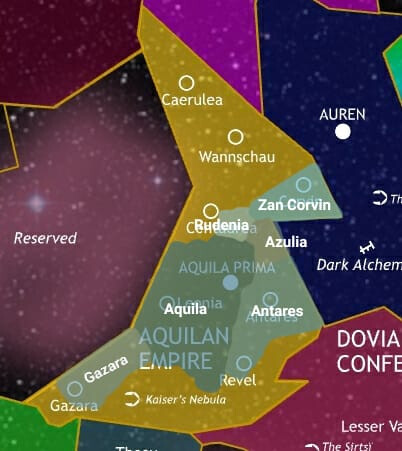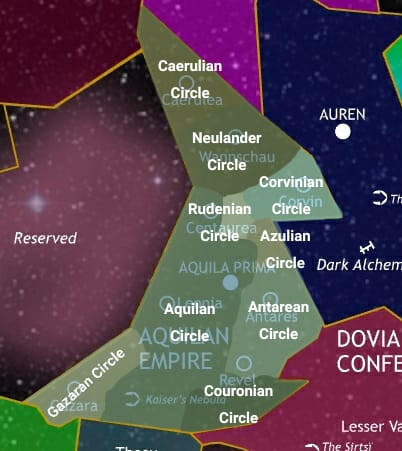Kharali Kharzurate (and successor states)
Time Period: 5248 – 154 BBT
Period Description: The Kharali Kharzurate was a spacefaring colonial slave empire established by the Kharali in 5248 BBT as a result of consolidation of the five original kharzunates of Ghorm, Ugrath, Ghorrak, Zulmak, and Drokor. After the end of the Third Kharali-Ruven War in 2208 BBT, the Kharali Kharzurate split into six kharzunates: Ghorm, Ugrath, Ushank, Ghorut, Sunger, and Kharal, with Ghorm and Ughrath being the most powerful. Kharali kharzunates continued to exist up until 154 BBT, when the Kharzunate of Ghorm was annexed by the Aquilan Empire following the War for Ghorm. Ghorm, which itself had consolidated the kharzunates of Sunger and Kharul under its dominionship since 1293 BBT, was the last remaining Kharali civilization to exist.
Species Makeup/Description: The most important species within the Kharali Kharzurate and its successor states are the Kharali: large, bipedal humanoids averaging 2,5 meters in height. They evolved from sentient trees back in their homeworld Kharal (modern day Caerulia). Today, the Kharali have drastically decreased in numbers thanks, in part, to centuries of conflict among each others and with foreigners. Most Kharalis today live in designated reservations and territories.
Technological Level: The Kharali are relatively advanced. Their biggest technological advancement was harnessing chlorophyll (or something analogous to it) for weapons and eventually space travel.
Nation Temperament: The Kharali Kharzurate (and its successor states) were generally expansionist, militarist, and colonialists. They viewed their expansion as part of their right.
Border Security/Integrity: The Kharzurate maintained a relatively strict border policy, something most of its successor states inherited. The Kharzurate and its successor states would often enslave those they conquered and those who pass their borders unannounced.
Attempts at Expansion or Exploration:
Kharali Kharzurate, 2432 BBT
Kharali Kharzunates after the fall of the Kharzurate, 2208 BBT
While these remain the core lands of the Kharali, they may have expanded beyond those lands.
Ruven Empire
Time Period: 5683 – 1212 BBT
Period Description: The Ruven Empire was a thalassocratic, merchantilic trade empire centered from their capital world of Ruva. The Ruven Empire focused largely on trade, forming outposts in subordinate lands through vassalage and patronage rather than ruling them outright. This led to the relative longevity of their empire. The ruling species were the Thalrakis, who never made up more than 26% of the empire’s population. Thalrakis were largely credited in bringing in Terran colonists to the empire, which led to the eventual shift in demographics. The Ruven Empire fell after a series of civil wars tore through the empire, leading to most of its vassals declaring total independence. What remained was a rump Ruven Empire, which consisted only of Ruva and surrounding planets, until the empire was absorbed by the Kingdom of Aquila in 1212 BBT as one of its vassal states.
Species Makeup/Description: While not the dominant species, the Thalrakis were the leaders of the Ruven Empire, being the dominant species in the imperial capital of Ruva. A bipedal reptilian-amphibian species, the Thalrakis, made up 26% of the population at its height. The dominant species since the 21st century BBT were Terrans, who were invited to settle in the empire. Today, Thalrakis make up a small percentage of Aquila’s population, concentrated in their homeworld of Ruva or some of the major urban areas, continuing their roles as merchants and traders.
Technological Level: The Ruven Empire was relatively advanced, especially as trade gave them access to much more advanced technology compared to their rivals the Kharali.
Nation Temperament: The Ruven Empire was a thalassocracy, and sought to expand via trade. Their expansions came through trade and consolidation, rarely through conflict. The only exception is Ruva’s conflict with the Kharali, which saw Ruva expand into former Kharali space via conquest.
Border Security/Integrity: The Ruven Empire was relatively lax in border policies, and are more than happy to freely let merchants and traders from outside the empire in so long as their merchants are also free to sell outside the empire. That said, the Ruven did keep a leash on their vassals, and would intervene if needed.
Attempts at Expansion or Exploration:
Ruven Empire, 2024 BBT
Beyond their core territories, the Ruven Empire may have also set up shops around their neighbors.
Zeniran Confederacy
Time Period: 1652 – 1428 BBT
Period Description: The Zeniran Confederacy existed as one of the largest “successor” of the old Ruven Empire. Originally a frontier province, the Zeniran Belt gained independence as the primary Terran nation in post-Ruven Aquila, and held sway over the small, independent Terran nations that popped up following Ruva’s fall. The Zeniran continued fighting the various Kharali kharzunates, namely Ugrath, Ghorut, and Ushank, after the fall of the Ruven Empire, and became a sort of wall preventing their expansion into the areas of the old Ruven Empire. In 1428 BBT, much of the Zeniran territories were annexed by the Kharzunate of Ugrath and lead to the dissolution of the Confederacy. Parts of the Confederacy which was not under Ugrathi control formed their own independent polities, which would later join with the Three Kingdoms to form what historians call the Quinumvirate.
Species Makeup/Description: Terrans were the majority in the areas of the Zeniran Confederacy. Today, many Terrans within Aquila who were in the so called “Zeniran Belt” have extremely strong cultural links.
Technological Level: The Zeniran were relatively advanced, inheriting much of the Ruven’s old technological advancements and knowledge
Nation Temperament: The Zeniran Confederacy was largely friendly to its neighbor, excluding the kharzunates.
Border Security/Integrity: The Zeniran Confederacy saw the lax security of the old Ruven Empire as one of the contributors of its fall. It developed a more secure border especially against the Kharali kharzunates.
Attempts at Expansion or Exploration:
Zeniran Confederacy, 1587 BBT
The Zeniran Confederacy didn’t make any notable attempts of expanding beyond their borders outside of the shifting borders between the Confederacy and the Kharzunate of Ugrath.
The Quinumvirate
Time Period: 1428 – 1004 BBT
Period Description: The Quinumvirate refers to the six Terran realms established in the wake of the fall of the Zeniran Confederacy through an invasion by the Kharzunate of Ugrath. These six realms were: Kingdom of Aquila, Kingdom of Antares, Kingdom of Zan Corvin, Sultanate of Gazara, Grand Duchy of Rudenia, and Grand Duchy of Azulia. The realms of Aquila, Antares, and Gazara were originally known as the Three Kingdoms, after they successfully expanded to fill most of the territories once held by the Ruvens. Zan Covin, Rudenia, and Azulia were successor states of the Zeniran Confederacy following its fall in 1428 BBT. During the War of the League of Harzburg (1022 – 1004 BBT), the Quinumvirate fought against Ughrathi aggression. The Dovian Empire intervened, fighting alongside the League from 1011 BBT. After the war ended and the Ugrathi kharzunate was dismantled, the League agreed to be incorporated into the Dovian Empire, a period which lasted until the former Quinumvirate declared independence during the Vor-Arï Wars, throwing their support on the King of Aquila’s claim to the Dovian throne and leading to the formation of the Empire in Aquila, eventually becoming the Aquilan Empire in 252 BBT.
Species Makeup/Description: Terrans were the majority in the areas of the Quinumvirate.
Technological Level: Expanding upon the technological innovations of the Ruvens and Zenirans, the Quinumvirate were also technologically advanced.
Nation Temperament: The six realms had rather different approach towards diplomacy. Aquila, seen as the largest and natural leader of the Quinumvirate, was more diplomatic, though it later developed a culture of militarism thanks to constant aggressions by Ugrath. Antares and Gazara also developed a mix of diplomatic, pragmatic, and militaristic temperaments similar to that of Aquila, reflecting their shared history as the Three Kingdoms. Zan Corvin, Rudenia, and Azulia largely inherited the more militant stance of the Zeniran Confederacy.
Border Security/Integrity: The Quinumvirate maintained relatively stricter border security, namely due to fears of expansions by their neighbors.
Attempts at Expansion or Exploration:
The Quinumvirate, 1022 BBT
Outside attempts of colonization within modern Aquila or the territories of the Kharali kharzunates, the Quinumvirate did not make any notable attempts at expanding beyond their borders.
Aquilan Empire
Time Period: 252 BBT – Today
Period Description: Aquila, officially known as the Aquilan Empire or the Grand Imperium of Aquila, is the official successor state to the Quinumvirate and the current residing political entity within the region. Founded unofficially when King Alexander II of Aquila declared himself as the rightful Dovian Emperor in the midst of the Vor-Arï Wars, founding what was then known as the Empire in Aquila in 258 BBT. The old Quinumvirate, after a series of discussions and secret treaties, threw their lot with Alexander II. In 252 BBT, with the likelihood of the Maximilan Dynasty securing their hold over Dovia decreasing each day, the Aquilans decided to break off from the Dovian Empire altogether to form the modern Aquilan Empire.
Species Makeup/Description: The majority of the population of the Aquilan Empire are Terrans.
Technological Level: Technologically advanced. Aquila developed innovations it inherited from the old empires that once ruled it as well as developing their own innovations.
Nation Temperament: Aquila has a martial tradition dating back to the Zeniran Confederacy, something it is extremely proud of. Nevertheless, Aquila has, since the end of the Hundred Years’ War, adopted a much less hawkish approach especially when it came to other Terran nations.
In the aftermath of the Hundred Years’ War between Aquila and Dovia, the Aquilan Empire became the center of a new ideology: Pan-Terranism. It is an ideology that believes Terrans/humans throughout the sector should cooperate rather than fight each other for the betterment of their species. The bloodshed from the Hundred Years’ War, seen as a senseless violence among brotherly nations, helped bring Pan-Terranism to the mainstream of Aquilan politics. Pan-Terranism seeks to empower Terrans throughout the known universe by bringing them back to the three core Terran values: Humanity, Ingenuity, and Tenacity. This led to eventual formation of the Pan-Terran League in 4 BBT.
Aquila today maintains diplomatic relations with most of its neighbors. It is also a founding member of both the Covenant of Fire and the Pan-Terran League.
Border Security/Integrity: Aquila, like the Quinumvirate before it, maintains a relatively strict border security. These were not universal however, as the borders between Aquila and some of its neighbors had been loosened thanks to diplomatic efforts as well as shared interests.
Attempts at Expansion or Exploration:
Imperial Circles of the Aquilan Empire, 0 BBT
During the Vor-Arï Wars, the Empire in Aquila annexed what would later became parts of the Gazaran, Aquilan, and Antarean circles. The Couronian Territories were also annexed following Aquilan independence, with them being elevated to the status of Circle much later.
Similarly, territories of the former Kharali Kharzurate were slowly annexed, which expanded the Aquilan, Rudenian, and Corvinian circles. The Neuland Territories, annexed following the War for Ghorm, were later reorganized into the Neulander and Caerulian territories.





